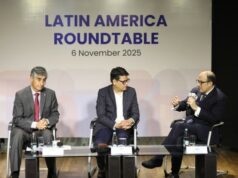The United States has unveiled what analysts describe as its most ambitious government-backed nuclear-energy expansion in decades, coupling trade and investment diplomacy with large-scale industrial mobilisation.
The development, analysed in the Critical Questions segment of the Center for Strategic and International Studies (CSIS) by Ray Cai, Jane Nakano and Joseph Majkut, marks a pivotal moment in U.S. energy and industrial strategy. Their report details how two cornerstone initiatives — a $550 billion U.S.–Japan investment agreement and an $80 billion partnership with Westinghouse Electric Company — could redefine the country’s approach to nuclear power.
In a parallel strategic move, President Donald Trump has also signalled his intention to resume nuclear explosive testing—a decision that, according to the International Institute for Strategic Studies (IISS), could mark “a return to an unstable nuclear age.”
In his recent analysis IISS Senior Fellow Dr Daniel Salisbury warns that restarting testing “on an equal basis” with other major powers would reverse nearly three decades of U.S. adherence to the global testing moratorium and risk unravelling arms-control norms. The institute notes that such a step would have implications far beyond deterrence, likely prompting reciprocal testing by Russia, China, and possibly emerging nuclear states.
If implemented, this shift would represent the most consequential break from the post–Cold War nuclear consensus since the 1996 Comprehensive Nuclear-Test-Ban Treaty (CTBT). The IISS cautions that the move could reintroduce competitive test-based weapons development into global nuclear politics, intensifying mistrust at a time when strategic stability is already under strain.
Last week, the White House released further information on the U.S.–Japan agreement, originally concluded earlier this year, which commits substantial capital to U.S. energy-technology deployment, including nuclear-reactor construction, power-plant components, grid infrastructure, and critical minerals. Simultaneously, Washington announced the Westinghouse partnership to build a fleet of new reactors across the United States. Taken together, these moves underscore a strategic shift in how America plans to finance, build, and manage the next phase of its energy transition.
Under the U.S.–Japan deal, Tokyo is expected to commit up to $550 billion before the end of the current U.S. presidential term in 2029. A joint fact sheet allocates roughly $100 billion each to Westinghouse and GE Vernova Hitachi for reactor construction, $25 billion each to Bechtel and GE Vernova for power equipment and services, and another $25 billion for Carrier’s cooling systems. Emerging advanced-reactor firms such as NuScale Power and ENTRA1 are also identified as beneficiaries, though without specified allocations.
The agreement establishes a U.S. investment committee chaired by the Commerce Secretary to oversee funding decisions from a newly created “Investment Accelerator” within the Commerce Department. Japan will mirror this effort through a Strategic Investment Facility under its export-credit agency. Financing will come from yen-denominated loans, dollar bonds, and allocations from foreign-exchange reserves.
Returns will be shared equally until Japan recovers its principal investment, after which the U.S. will receive 90 percent of the profits. The U.S. government, for its part, will provide federal land, utilities access, and fast-track regulatory clearances, while Japanese companies will enjoy supplier priority in eligible projects.
In parallel, the $80 billion partnership with Westinghouse—owned by Brookfield and Cameco—will receive government support for financing, land acquisition, and permitting. In exchange, the U.S. government will gain a contingent right to 20 per cent of profits above $17.5 billion, or an equity stake of up to 20 per cent if the company’s valuation exceeds $30 billion by 2029.
The CSIS analysis situates these announcements within a broader continuum of industrial-policy initiatives designed to rebuild domestic nuclear capacity.
The Biden administration’s earlier policy moves — including tax credits under the Inflation Reduction Act and expanded loan-authority provisions via the One Big Beautiful Bill Act (OBBBA) — laid the groundwork for this latest phase of activity. After years of stagnation and cost overruns, such as those witnessed in the Plant Vogtle expansion in Georgia, these new partnerships are intended to rekindle investor confidence and stabilise the supply chain around advanced nuclear technologies.
Yet the authors caution that significant uncertainties remain over implementation. Chief among them is how the proposed funds will actually be deployed and managed. Details of the new Investment Accelerator’s structure and legal authorities remain unclear, particularly how it will differ from the Department of Energy’s previous financing model under the Loan Programs Office (Title XVII). The lack of transparency, they note, leaves open questions about governance, risk allocation, and accountability.
Equally critical is the issue of offtake commitments — the long-term power-purchase arrangements that underpin the financial viability of nuclear projects. While the agreements spotlight service and equipment providers, the report underscores the absence of clear utility or federal off-takers that would guarantee revenue streams. Without such anchors, financing for multi-billion-dollar reactor projects could remain fragile, even with robust government backing.
Other challenges include workforce development, supply-chain scalability, waste-management infrastructure, and regulatory bottlenecks. Cost overruns, construction delays, and multi-layered permitting remain persistent risks. The CSIS authors point out that for these projects to succeed, early coordination on siting, licensing, and regulatory streamlining will be essential.
At a strategic level, the analysis frames these developments as part of a wider re-industrialisation effort, where nuclear power is positioned alongside semiconductors, clean energy, and critical minerals as core components of U.S. national-security and economic policy. By aligning Japanese capital with American industrial ambitions, the administration aims to strengthen supply-chain resilience and reassert technological leadership in the global energy transition.
However, as the CSIS report makes clear, the success of this initiative will hinge on execution rather than ambition. While the framework signals a bold revival of U.S. nuclear capability, the mechanics of funding deployment, offtake structuring, regulatory reform — and now the renewed prospect of nuclear-weapons testing — will determine whether this becomes a genuine nuclear renaissance or another cycle of stalled projects.
In a career spanning three decades and counting, Ramananda (Ram to his friends) has been the foreign editor of The Telegraph, Outlook Magazine and the New Indian Express. He helped set up rediff.com’s editorial operations in San Jose and New York, helmed sify.com, and was the founder editor of India.com.
His work has featured in national and international publications like the Al Jazeera Centre for Studies, Global Times and Ashahi Shimbun. But his one constant over all these years, he says, has been the attempt to understand rising India’s place in the world.
He can rustle up a mean salad, his oil-less pepper chicken is to die for, and all it takes is some beer and rhythm and blues to rock his soul.
Talk to him about foreign and strategic affairs, media, South Asia, China, and of course India.





